
|   |

|   |
 e-mail: leelakaverivenkat@gmail.com Marking World Dance Day in style Photos: Sarabjit Dhillon May 11, 2016 From the start, it was as if the fairy godmother's magic wand had been waved over each session of Natya Vriksha's two day World Dance Day 2016 celebrations at the IIC, Delhi. Organised and curated by founder president Geeta Chandran and spouse Rajiv Chandran, this annual celebration supported by the IIC and the Ministry of Culture, has been, with each year, expanding its horizons with a holistic perception, adding to the performance nucleus of the Young Dancers Festival with other allied interests. This year, woven round the performance side, were sessions dealing with "Studio Class Demo", "Tribute to Dance Doyennes" and Workshop on Muscle Memory as part of the calendar of events. 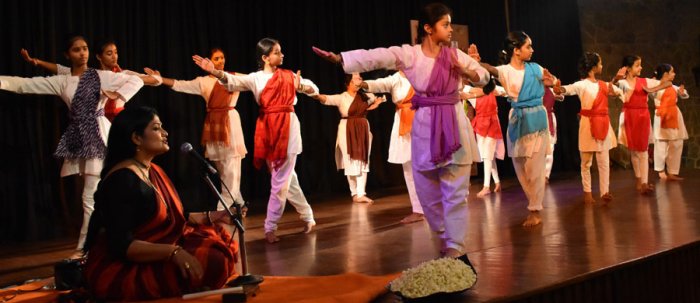 Bharatanatyam class by Geeta Chandran at Natya Vriksha After an invigorating start with a public demonstration of Bharatanatyam class at Natya Vriksha conducted by Geeta Chandran, came the afternoon dialogue with Yamini Krishnamurti weaving magic - the packed auditorium, with Yamini's total absence of artifice and her "in your face" answers making for a bristling, riveting couple of hours for all present - with a mix of humour, unpredictability, brutal frankness and a certain contradictoriness. And full marks to Geeta for posing the right questions drawing out an unusually loquacious avatar of Yamini! Born on full moon as the Poornatilakam, her grandfather named her Yamini. She described herself as a stubborn, difficult child. The constant prodding produced vivid images of earliest memories - of wandering round the Nataraja temple at Chidambaram and watching the dance sculptures, of the family's Madanapalli stay with time spent watching the trains pass by, while coping with a stream of teachers teaching violin, dance, music and veena not to speak of an old devadasi who sang a lot: of the Chennai stay when roughly 11 years with father putting her into Rishi Valley School - and taking her out when he found it not fitting into her dance routine. She just danced, for that was life. She could not decide if she loved or hated it. She was programmed to dance by destiny, she felt. She did not want to be born again. Did she secretly resent her life being totally programmed by her father Professor Krishnamurti? Contrarily she maintained, "He was my greatest friend, supervised all my rehearsals too. I loved him and still miss him a lot." Her life has been as a 5am - 10pm dancer who has not seen more than five films in her entire life! As for preferences in food -she treats eating as a means of keeping the body alive! She recollects moments in Kalakshetra- practising constantly in the mirror room, dancing in the Kuravanji ballet with Attai, getting the diploma - all as planned. "I got along invariably well with all my later Nattuvanars - Kittappa Pillai, Ellappa Pillai, Dandayudapani Pillai- who talked a lot. That kind of talk and leisurely teaching cannot be experienced today." I learnt innumerable items and my sister Jyotishmati, who sang for me, was also a very quick learner and that helped." 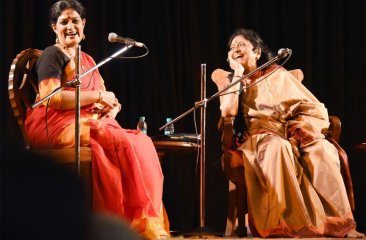 Geeta Chandran and Yamini Krishnamurti Photo: Pranit The first devadasi fragrance came through Gowri Amma, "a tragic figure". "The best way to please her was to treat her to a really good meal." Later Gurus were Laxminarayana Sastry, Venugopal Sarma teaching her Kuchipudi and Pankaj Charan Das training her in Odissi. Her performances attracted three groups of people - those who came to listen to her widely read father whose wonderful grasp over Sanskrit and the dance made his introductions to her dance memorable, those who came to hear Jyotishmati singing and those who came to see her dance. She vividly recollects the day she saw Bala dance. "When I commented that she did not look attractive, I was told to wait and see. And see I did - I was drawn into a magic circle - I recollect her brilliant singing; she flew like a bird. I went home, a totally dejected figure, and told my father that I would not dance henceforth for I could never come near what I had seen. Father consoled me that I too will become great.....The other person who held my attention, though very different, was Shanta Rao - her dance had such power! NO other dancer has impressed me." Talking highly of the mental stamina and energy to carry on that she got from the audience, which was her real support, she dismissed any government contribution. "Dance has to come from within you. What can Government do?" Yamini perhaps forgot, in the heat of the moment the awards of recognition and that she still lives in government's generously sized accommodation -an unimaginable blessing in a crowded city like the capital! And hers is the generation which has enjoyed the maximum government goodwill and largesse. She finds that total commitment and the magic surrounding dance, lacking today. Dance aspirants treat the dance as one of the many activities in life. The session offered a rare peep into an obsessive extraordinary life of dance. 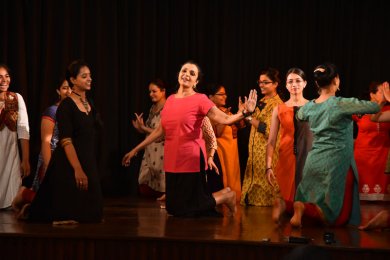 Anita Ratnam's workshop The other fascinating non-performance event was the muscle memory workshop conceived and conducted by Anita Ratnam. There were so many takers that the aisles had to be filled since the stage had no space for all. The entire session was looking at this body with its movement memories coming from formal dance routines and what was imbibed from parental inputs and everyday postures. "What the muscle retains as memory can be quite different from what the mind has processed through formal dance lessons." In a sense the body trying to free itself of the locked situation of movement vocabulary tailored by formal dance lessons, was very interesting for the participants. And Anita's very original sound tape, added to the session which included "voice, breath, movement and dance." 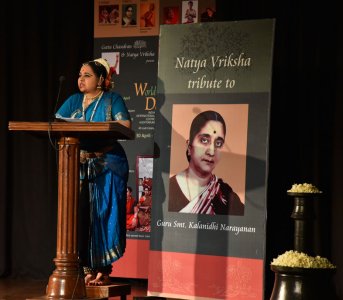 Rasika Khanna Homage to late abhinaya doyenne Kalanidhi Narayanan by some of her seniormost students talking about their personal experiences and presenting glimpses of their learning, made for another evocative session. Rasika Khanna referred to as the 'Punjabi Ponnu' by Kalanidhi's husband, threw interesting insights into how Mami encouraged one to think out of the box as in "Theruvil Varano" with her creative imagination in devising sancharis. Mami first introduced her to a mugdha character, wondering why she was the subject of gossip, based on the Kamas lyric "Apadorukulaitinai." When her guru Adyar Lakshman suggested that Mami was resorting too much to the seated position in her teaching, and that the standing position with rhythm needed to be inbuilt in abhinaya, Kalanidhi, without qualms accepted the criticism readily and changed her teaching approach. Rasika presented the Kalyani padam "Ettai kandu ichhai kondai magale" starting with the Anupallavi line "Suddha Payittiyakkaaran Gangadharan" line with the mother dilating on the quixotic ways of Shiva, wondering what daughter Parvati had fallen for. 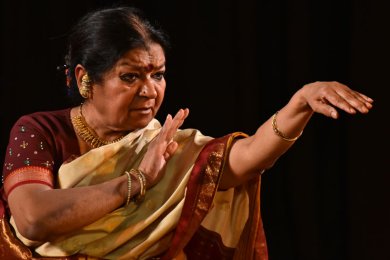 Jamuna Krishnan Jamuna Krishnan's screened video clippings of Kalanidhi Mami teaching both her daughters Rohini and Ragini, was followed by stating how for Mami, sringar was always the king of rasas and in her approach the spiritual and the erotic were intertwined. After presenting her own choreography in sringar, to the Kabir song "Hari mere peer, Hari bina rahe na sake mere jeeva", came Jamuna's super rendition of Kshetrayya's "Payyada" portraying the ache of the nayika now alone, recollecting, with the sakhi the days when her beloved without blinking, would not take his eyes off feasting on her beauty. With Sudha Raghuraman putting all she had into the singing of the Nadanamakriya, and the stillness, of each moment held in time, the nayika's deep ache was an intense bit of abhinaya, evoking many wet eyes. 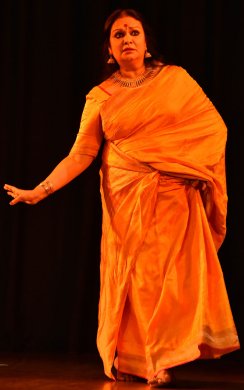 Prathibha Prahlad Prathibha Prahlad talked about Kalanidhi with no qualms whatsoever pillion riding through Chennai, on Prathibha's moped. She had confided her distress to Mami about the fellow artists gossiping about her unorthodox choices in life and Mami taught her the javali 'Intsuboni' (which became her favourite) where, facing a similar situation the nayika dares the gossip mongers if there was one amongst them who was not hiding skeletons in the cupboard. Presenting a sensitive sringar interpretation of the ashtapadi "Sakhiye keshi mathanam udaram", Prathibha cited this as an example of Mami's open mindedness. Prathibha's preference for this ashtapadi set to music in the raga Suddha Sarang was different from what Mami had taught her. After seeing the rendition, Mami had unabashedly agreed that the version in this raga became the mood better. 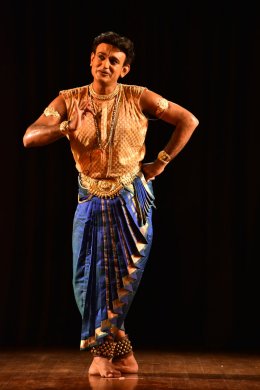 Vasudevan Iyengar Among performances, Dr. Vasudevan Iyengar known more for his Carnatic vocal expertise and nattuvangam, was an utter revelation as a solo dancer. Melaprapti, a devotion soaked rendition of Syama Sastry's Bhairavi swarajati "Kanchi Kamakshi" followed by the tillana in Suratti deservedly earned him a standing applause from the audience. The improvised unending sancharis in the swarajati visualising the splendour of Goddess Kamakshi, sprang as much from the music-knowing background as from Vasu's naturally deep spiritual inclinations. With Venkateshwar's equally moving vocal support, and the strong nattuvangam of Shankar not to speak of specially-in-form mridangist Chandrasekhar's phenomenal percussion support, the recital reached rare excellence. The Pallavi line however, after the elaborate prelude of the "Srigaradhra" verses, expanding into non-stop abhinaya elaborations, compelled Venkateshwar to go in for some musical touches - not strictly in line with Shyama Sastry's musical composition, which in any case, was not composed for dance. Distributing the abhinaya ideas throughout the swarajati without a too long Pallavi would enable preserving the version of the composer without frills. But this apart, Vasu's was a rare Bharatanatyam treat of dancer merged in the dance. 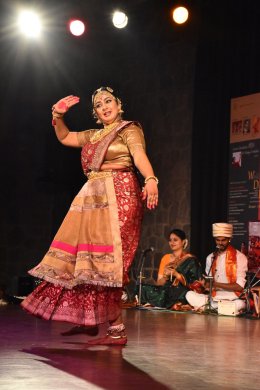 Swarnamalya Ganesh "The Attic," an interactive presentation by Chennai's Dr. Swarnamalya Ganesh was another very special performance. This journey of 'tracing the unknown through the known', resorting to whatever historical material is available of a bygone era of early and medieval India, and recreating from the studies an imagined past, from which must have evolved our jatis, jatiswarams and varnams, is an arduous intellectual/artistic endeavour and Swarnamalya's introductions followed by dance renditions charmed the audience. The Bhairavi centrepiece blending abhinaya and nritta with the nayika addressing her love plaint to the beloved "nee varuvai enave......ninai villaiy duraisami" struck by the arrows of Manmatha was certainly reminiscent of the varnam. Swarnamalya has a most expressive face and compulsive presence, notwithstanding the heavy body and her performance had deep conviction which communicated to the audience. And with what elan the dancer did "O my lovely Lalana, Elane Pommanti, Ituvanti Step is it fit to take..." showing what had happened to the Telugu Javali with the devadasi wanting to address British peers and merchants. And equally fascinating was what was called Jakkini in many Indian texts the "Elilaam", Ilai, Ilaho, and words close to it showing performers responding to the combined Judaism, Christian, Islamic, Hinduism influences - the item as conceived by Swarnamalaya resembling whirling movements like the dance of the Dervishes. Altogether a fascinating combination of research and creative imagination! 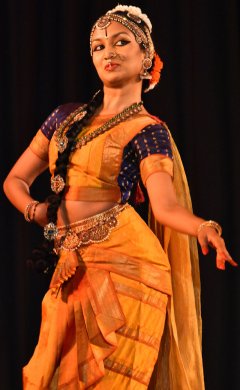 Bhavana Reddy Young Kuchipudi dancer Bhavana Reddy, the youngest member of the Reddy family, is undoubtedly extremely talented. More consistently strong vocal support by singer Lavanya, who wavered between conviction, and shaky vocal support, was needed for the recital, which lacked the flow and unified feel despite Kaushalya's nattuvangam power and Bhasker Rao's mridangam. Rhythmically very confident, the dancer's interpretative part based on Bhama Kalapam, required more subtlety in portraying the unpredictable heroine. More internalised presentation coming with life experience will change what seems Bhavana's somewhat superficial abhinaya. Self confident, the dancer made a vivacious spirited entry with prayer to Ganesh. But I would appeal to Raja for a more strongly Kuchipudi feel in the choreography with the typical bobbing up and down movements of the dancer - than what at present, to any but the most experienced viewers, seems to have a strong Bharatanatyam feel to it. 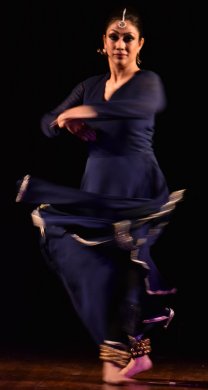 Sanjukta Sinha One of Kumudini Lakhia's most promising younger dancers, Sanjukta Sinha, for some unknown reason has never been called to Delhi for a solo performance. Artistically turned out, her breezy nritta was there for all the audience to see with every movement or chakkar etched in grace and perfection. But she needs to contain so much of love for speed from start to finish. With sringar passages woven into the presentation one looked forward to a certain savoured slowness in interpretation without the unceasing breakneck tempo. If she makes her dance balanced in both slow grace and speedy excitement, she will be a unique find indeed. Her accompanying music, comprising really talented musicians, was poorly balanced with singing voice, instruments and percussion not finding complete sruti alignment. But altogether a most rewarding two-day event!  Writing on the dance scene for the last forty years, Leela Venkataraman's incisive comments on performances of all dance forms, participation in dance discussions both in India and abroad, and as a regular contributor to Hindu Friday Review, journals like Sruti and Nartanam, makes her voice respected for its balanced critiquing. She is the author of several books like Indian Classical dance: Tradition in Transition, Classical Dance in India and Indian Classical dance: The Renaissance and Beyond. Post your comments Please provide your name and email id when you use the Anonymous profile in the blog to post a comment. All appropriate comments posted with name & email id in the blog will also be featured in the site. |